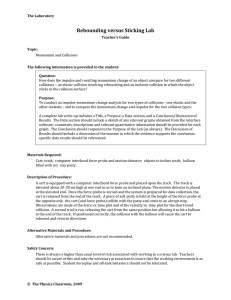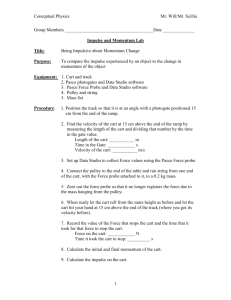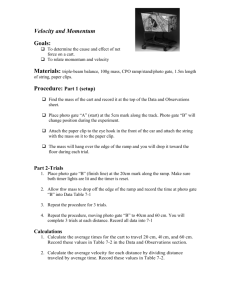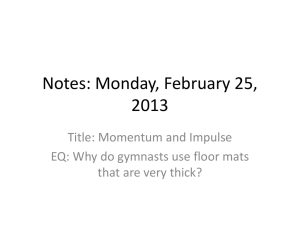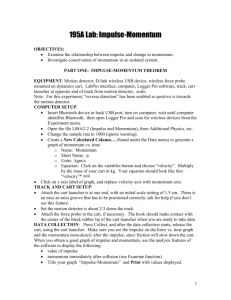MS Word - The Physics Classroom
advertisement
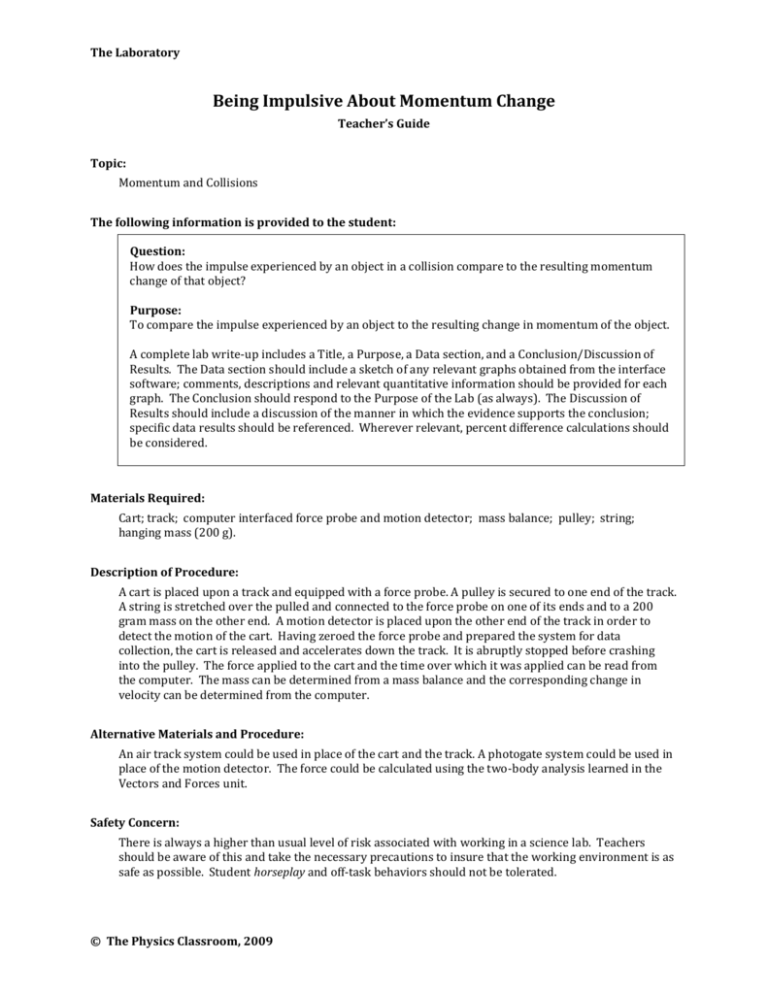
The Laboratory Being Impulsive About Momentum Change Teacher’s Guide Topic: Momentum and Collisions The following information is provided to the student: Question: How does the impulse experienced by an object in a collision compare to the resulting momentum change of that object? Purpose: To compare the impulse experienced by an object to the resulting change in momentum of the object. A complete lab write-up includes a Title, a Purpose, a Data section, and a Conclusion/Discussion of Results. The Data section should include a sketch of any relevant graphs obtained from the interface software; comments, descriptions and relevant quantitative information should be provided for each graph. The Conclusion should respond to the Purpose of the Lab (as always). The Discussion of Results should include a discussion of the manner in which the evidence supports the conclusion; specific data results should be referenced. Wherever relevant, percent difference calculations should be considered. Materials Required: Cart; track; computer interfaced force probe and motion detector; mass balance; pulley; string; hanging mass (200 g). Description of Procedure: A cart is placed upon a track and equipped with a force probe. A pulley is secured to one end of the track. A string is stretched over the pulled and connected to the force probe on one of its ends and to a 200 gram mass on the other end. A motion detector is placed upon the other end of the track in order to detect the motion of the cart. Having zeroed the force probe and prepared the system for data collection, the cart is released and accelerates down the track. It is abruptly stopped before crashing into the pulley. The force applied to the cart and the time over which it was applied can be read from the computer. The mass can be determined from a mass balance and the corresponding change in velocity can be determined from the computer. Alternative Materials and Procedure: An air track system could be used in place of the cart and the track. A photogate system could be used in place of the motion detector. The force could be calculated using the two-body analysis learned in the Vectors and Forces unit. Safety Concern: There is always a higher than usual level of risk associated with working in a science lab. Teachers should be aware of this and take the necessary precautions to insure that the working environment is as safe as possible. Student horseplay and off-task behaviors should not be tolerated. © The Physics Classroom, 2009 The Laboratory Suggestions, Precautions, Notes: 1. 2. Some software programs which accompany interface equipment have the capability of creating, displaying and graphing a calculated quantity. For instance, a column of momentum data could be calculated from the measured data. For a 0.750 gram cart (force probe included), the column could be defined as momentum and set equal to 0.750*(x-Velocity). Using this feature makes the connection between impulse and momentum change a more visible connection. Some software programs which accompany interface equipment are able to determine the area below a force vs. time curve. This area is the impulse experienced by the object. Auxiliary Materials: None Scoring Rubric: M1. Being Impulsive About Momentum Change Lab Included, labeled and organized all parts of the lab report. Data section includes quantitative information relevant to the purpose, presented in an organized and informative manner. Such information could include graphs, slope values, data tables of impulse and momentum, etc. Data is reasonably accurate. Data provides evidence which can support an answer to the question posed in the Purpose. Labels, units and calculations are shown. Conclusion/Discussion answers the question posed in the Purpose. Evidence to support the conclusion is presented and elaborated upon; the manner and the extent to which the data support the conclusion is discussed. A percent difference calculation is used in the discussion; work is shown. Connections to The Physics Classroom Tutorial: The following readings are a suitable accompaniment to this lab: http://www.physicsclassroom.com/Class/momentum/u4l1a.cfm http://www.physicsclassroom.com/Class/momentum/u4l1b.cfm Connections to Minds on Physics Internet Modules: Sublevel 2 of the Momentum and Collisions module is a suitable accompaniment to this lab: http://www.physicsclassroom.com/mop/module.cfm © The Physics Classroom, 2009 Score _____/_____
